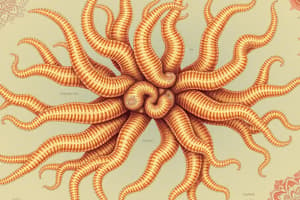Podcast
Questions and Answers
What is the domain classification of sponges?
What is the domain classification of sponges?
- Eukarya (correct)
- Protista
- Archaea
- Bacteria
Which of the following is NOT a characteristic of sponges?
Which of the following is NOT a characteristic of sponges?
- Asymmetrical
- Internal skeleton
- Have true tissues (correct)
- Filter feeders
What is the least complex type of sponge?
What is the least complex type of sponge?
- Ascon Sponge (correct)
- Sycon Sponge
- Leucon Sponge
- None of the above
What are spicules made of in Calcarea sponges?
What are spicules made of in Calcarea sponges?
What class do bath sponges belong to?
What class do bath sponges belong to?
What type of spicules do Hexactinellida sponges have?
What type of spicules do Hexactinellida sponges have?
What is the role of pinacocytes in sponges?
What is the role of pinacocytes in sponges?
What is the function of choanocytes in sponges?
What is the function of choanocytes in sponges?
How does water flow through a sponge?
How does water flow through a sponge?
What are the two types of asexual reproduction in sponges?
What are the two types of asexual reproduction in sponges?
Sponges reproduce sexually only when environmental conditions are unfavorable.
Sponges reproduce sexually only when environmental conditions are unfavorable.
What does a gemmule contain?
What does a gemmule contain?
Flashcards are hidden until you start studying
Study Notes
Sponge Classification
- Domain: Eukarya
- Kingdom: Animalia
- Phylum: Porifera, meaning "pore bearing"
Sponge Characteristics
- Exhibit asymmetry
- Function as filter feeders
- Lack true tissues
- Possess an internal skeleton made of spicules or collagen fibers
Sponge Body Types
- Ascon Sponge: Least complex structure
- Sycon Sponge: Intermediate complexity
- Leucon Sponge: Most complex, efficient in extracting oxygen and food particles
Calcarea Class
- Comprises marine sponges
- Characterized by small, needle-shaped spicules made of calcium carbonate with 3-4 rays
- Can exhibit ascon, sycon, or leucon body types
Demospongiae Class
- Commonly known as bath sponges or commercial sponges
- Features beautifully colored marine sponges with skeletons made of spongin
Hexactinellida Class
- Comprises marine sponges with six-rayed spicules made of silica
- Can display sycon or leucon body types
- Some taxa inhabit freshwater environments like streams, ponds, and lakes
Spicules
- Structural components that provide support and deter predators; can be made from calcium carbonate or silica
Sponge Structure - Pinacocyte
- Flattened cells that form the outer body wall of the sponge
Sponge Structure - Amoebocyte
- Mobile cells capable of transforming into various cell types, responsible for transporting food within the sponge
Sponge Structure - Porocyte
- Doughnut-shaped cells that facilitate water flow into the radial canals
Sponge Structure - Choanocyte
- Also known as collar cells, they line the radial canals, using flagella to capture food particles, aiding in the sponge's filter-feeding process
Water Flow Through the Sponge
- Water enters through ostia (pores)
- Moves through incurrent canals via porocytes
- Flows into radial canals lined with choanocytes
- Enters the spongocoel (the central chamber)
- Exits through the osculum
Importance of Water Transport in Sponges
- Essential for respiration, nutrient transport, digestion, and excretion
- Allows exchange of oxygen, nutrients, and waste via diffusion and water currents
Asexual Reproduction
- Two main types: fragmentation and budding
Fragmentation
- Sponges break into parts capable of regenerating into new individuals
Bud Formation
- External buds: small sponges detach from the parent
- Internal buds, or gemmules: balls of amoebocytes encased in spongin and spicules that survive harsh conditions
Sexual Reproduction
- Occurs when conditions are favorable
- Choanocytes transform into haploid sperm via meiosis and are released into the water
- Sperm enter a different sponge, fuse with a haploid egg, and develop into ciliated larvae that settle and mature into new sponges
Asexual Reproduction: Gemmule Diagram
- Represents the structural components associated with gemmule formation and resilience
Studying That Suits You
Use AI to generate personalized quizzes and flashcards to suit your learning preferences.




